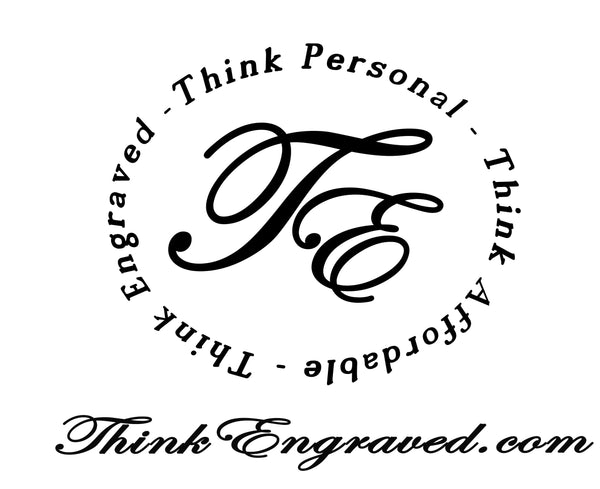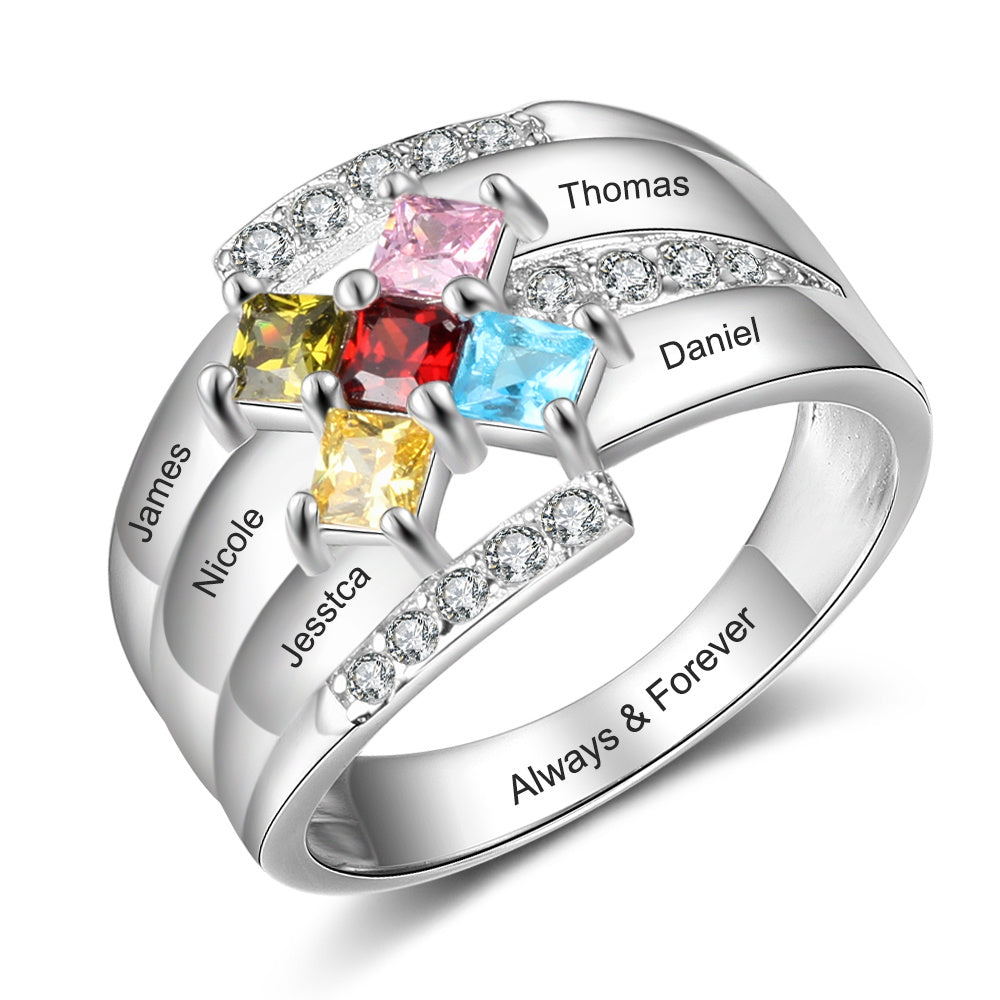Not everyone has heard of a mother's ring and when they do, there are 7 common questions or variants of questions that we get a lot.
With that said, here are the questions and our answers:

You can buy this ring here
What is the origin of the mother's ring?
The origin of the mother's ring can be traced back to the early 20th century. The concept gained popularity in the United States during the 1950s.
The idea behind the mother's ring is to create a piece of jewelry that symbolizes the family and the bond between a mother and her children.
Typically, a mother's ring features the birthstones of each of her children, arranged in a design that is aesthetically pleasing.
The birthstones are often set in a ring, pendant, or other piece of jewelry. Each birthstone represents a specific month associated with the birth of one of the mother's children.
The concept of the mother's ring has evolved over time, and today, there are various designs and styles available to suit individual preferences.
Some may also include engravings, additional gemstones, or other personal touches. It has become a popular and sentimental gift for mothers, symbolizing the unique and cherished connection between a mother and her children.

When did mothers rings become popular?
Mother's rings became popular in the United States during the 1950s. The concept gained widespread acceptance, and the jewelry industry began offering designs specifically tailored to celebrate motherhood.
During this time, people began to embrace the idea of creating personalized jewelry that represented the family unit.
The rings typically feature the birthstones of a mother's children, arranged in a design that holds sentimental value.
Since the 1950s, the popularity of mother's rings has continued to grow, and they have become a cherished and sentimental gift for mothers on various occasions such as birthdays, Mother's Day, or other special milestones in a family's life.
The concept has also expanded to include other types of jewelry, allowing for a wide range of personalized and customizable options.
What does the mother's ring symbolize?
A mother's ring is a piece of jewelry that symbolizes the unique and special bond between a mother and her children. It typically includes the birthstones of each of the mother's children, arranged in a design that holds sentimental value.
The birthstones represent the specific months in which each child was born.
The symbolism of a mother's ring is deeply personal, but it often conveys the following sentiments:
-
Family Connection: The ring serves as a visual representation of the family unit, bringing together the birthstones of each family member. It symbolizes the unity and connection within the family.
-
Motherhood: The ring celebrates the role of motherhood, acknowledging the love, care, and devotion that a mother has for her children.
-
Individuality: The use of birthstones adds a personal touch to the jewelry, recognizing each child's uniqueness and individuality. The arrangement of the stones can be a reflection of the birth order or other meaningful configurations.
-
Memories: The birthstones also serve as reminders of significant moments—the births of the children—that hold a special place in the mother's heart.
-
Sentimental Value: Mother's rings are often given as gifts on occasions like Mother's Day, birthdays, or other milestones. As such, they carry sentimental value and become cherished keepsakes for the mothers who receive them.
Ultimately, the meaning of a mother's ring is subjective and can vary from person to person. It serves as a beautiful and tangible expression of the love and connection within a family.

What stones go on a mothers ring?
The stones that go on a mother's ring typically represent the birthstones of her children. Each birthstone corresponds to a specific month, and the arrangement of these stones on the ring is often based on the birth order of the children or other personal preferences.
Here is a list of birthstones by month:
- January: Garnet
- February: Amethyst
- March: Aquamarine
- April: Diamond
- May: Emerald
- June: Pearl or Alexandrite
- July: Ruby
- August: Peridot
- September: Sapphire
- October: Opal or Tourmaline
- November: Topaz or Citrine
- December: Turquoise, Zircon, or Tanzanite
A mother's ring can be designed to include the birthstones of all her children, with each stone set in a way that is visually appealing and meaningful.
Some mothers may also choose to include additional stones, such as their own birthstone or the birthstone of a spouse.
The arrangement of the stones on the ring is a personal choice, and there are various designs available, ranging from simple bands to more intricate and artistic arrangements.
Many jewelry stores offer customizable options for mother's rings, allowing individuals to create a unique and sentimental piece that reflects their family.
What gemstone represents a mother's love?
While there isn't a specific gemstone universally associated with representing a mother's love, many people consider certain gemstones to carry meanings of love, nurturing, and protection.
These gemstones are chosen for their symbolic significance rather than any inherent mystical properties.
Some gemstones that are often associated with maternal qualities and love include:
-
Rose Quartz: Known as the "stone of love," rose quartz is often associated with unconditional love, compassion, and emotional healing. It is considered a nurturing and calming stone.
-
Pearl: Pearls are often associated with purity and love. They are considered to bring a sense of calmness and promote feelings of love and compassion.
-
Moonstone: Moonstone is associated with feminine energy and is believed to enhance intuition and emotional balance. It is often considered a symbol of motherhood and protection.
-
Aquamarine: Aquamarine is associated with tranquility, courage, and clear communication. It is believed to bring a sense of calmness and protection, qualities that resonate with maternal love.
-
Ruby: Ruby is a gemstone associated with passion, love, and protection. It is often considered a symbol of deep and enduring love.
It's important to note that the symbolism of gemstones is largely based on cultural and historical traditions, and individual preferences play a significant role in choosing a gemstone that holds personal meaning.
When selecting a gemstone to represent a mother's love, consider the individual qualities associated with the gemstone as well as personal preferences and significance.
Does a mothers ring have the mothers birthstone?
Whether or not a mother's ring includes the mother's birthstone is entirely a matter of personal preference.
Some mothers prefer to include their own birthstone along with the birthstones of their children, while others may choose not to.
The design and composition of a mother's ring are highly customizable, allowing for a range of options based on individual preferences.
Some mothers appreciate the idea of having their birthstone as a central focus, symbolizing their presence at the heart of the family.
Others may prefer a design that exclusively features the birthstones of their children, emphasizing the unique identity of each child.
There are also variations where the mother's birthstone is set alongside the children's birthstones.
Ultimately, the decision depends on what holds the most sentimental value for the mother.
The beauty of a mother's ring lies in its ability to be personalized to reflect the specific family dynamic and the emotional connections within the family.

How do you wear a mother's ring?
The way a mother's ring is worn depends on personal preference, and there are no strict rules governing its placement.
Here are a few common ways that mothers may choose to wear their rings:
-
Ring Finger of the Right Hand: Traditionally, the ring finger of the right hand is a common choice for wearing a mother's ring. This finger is often associated with commitment and family bonds.
-
Ring Finger of the Left Hand: Some mothers choose to wear the ring on the ring finger of the left hand, alongside or instead of a wedding or engagement ring.
-
Middle Finger or Index Finger: Mothers may opt to wear the ring on the middle finger or index finger of either hand.
-
Multiple Rings on One Finger: If a mother has multiple rings, she may choose to wear them on the same finger or distribute them across different fingers.
-
Necklace or Pendant: In addition to or instead of wearing the ring on a finger, some mothers choose to wear a mother's ring as a necklace or pendant. This allows for a different and often more versatile way to showcase the piece.
Ultimately, the choice of how to wear a mother's ring is a personal one, and there are no strict guidelines. It depends on the individual's comfort, style preferences, and the symbolism they wish to convey.
The most important aspect is that the mother feels a connection to and enjoys wearing the ring in a way that holds significance for her.
Be sure to check out our large selection of beautiful mother's rings here

